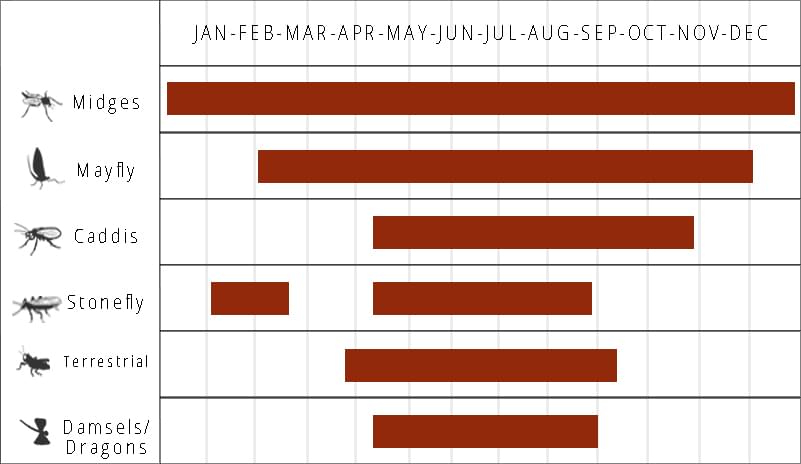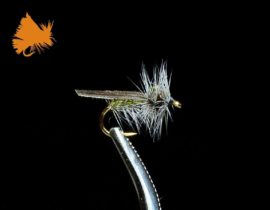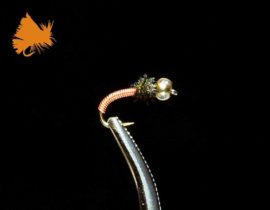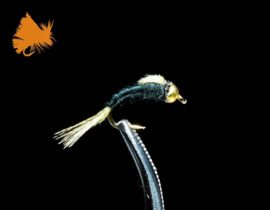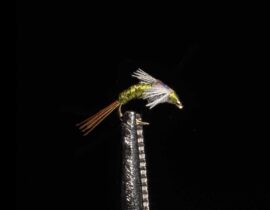On the other side of the wigwam club private water below cheeseman, the South Platte River Deckers section begins and continues to the confluence with the north fork of the south platte. This section has a ton of fish and is only an 60-90 minutes from the front range. The proximity to denver makes this place often pretty crowded, but with some driving, you can find open water. There are miles of fishable water and the fish are plentiful. There are more fish above the bridge in deckers most times, but there are also 3x the amount of crowds. Fishing downstream of the bridge often yields more fish. I’ve seen some real beasts down there too, so don’t overlook these sections. There are a lot of 18”+ fish in the river that are worthy of a picture or two. Practice good catch and release here as the fish get pressured hard. It’s a fun and challenging place to fish for the day.
With only a short drive from Denver or Colorado Springs, the deckers tailwater section is one the closest and most attractive places to catch sizeable trout on a Colorado tailwater. Fish ranging 10” all the way up to 24” have been caught in this section and each year, it consistently produces big trout. These trout have access to strong fish habitat and a ton of insect life to help them grow big and strong. Their colors can be vibrant and memorable leaving you with a sense of satisfaction and a great Colorado adventure.
Tailwaters are notoriously difficult to fish in Colorado and this one is no exception. Beginners can’t expect to have double digit fish days on most occasions and even with the right set of skills fishing can be fickle. That’s the bad news. The good news is that these fish are almost always eating and will take a well presented fly. Fly selection and presentation in combination are critical for success on this river. As you’ll see below when we get to the fly section, there are a ton of insects in the river and you can spend the better part of your day changing flies and not catching fish. Even if you have the right fly on, they still get pretty wise to you with all the pressure this place receives and without a good presentation, you’ll find little success.
Don’t let all that discourage you however, this guide is meant to give you a huge edge over the average joe who walks up to the river. Let’s dive into a little more about what we can expect in terms of the river and then we will provide some tips on how to make the most out of your adventure on the South Platte deckers tailwater.
RIVER CHARACTERISTICS
The river is very characteristic to the south platte watershed and runs through a thick pine forest that is covered in gravel rocks. The river bottom is a mix of this gravel in some areas and other ares river stones persist making this the most fishable parts of the river. Insect life doesn’t do well and the river runs fast through the gravel making it less than ideal habitat. Anywhere the water slows or river stones persist, is often where the best fishing is. There are so many pull offs as it’s a well fished area that you’ll be able to see where others fish and it’s wise to follow in their footsteps. The river, as all rivers do, goes from runs to riffles to holes as it meanders for miles from below the wigwam club down to the confluence of the north fork before it drops into Strontia springs reservoir. There is a good mix of pocket water, fishy runs, and mysterious holes that keep you excited to fish at every turn of the river.
TIPS ON FISHING DECKERS SECTION OF THE SOUTH PLATTE RIVER
Now that you understand a little more about what the river looks like and has to offer, let’s talk about a few of the tips I’ve learned over the years to make the most out of any day at deckers.
KEEP FLIES SMALL & IMITATIVE
You can catch them on attractor patterns for sure, but most of the takes are going to be very imitative. When there are lots of insects in the water, fish become selective and need insects that look the part. They won’t feed as opportunistically as you’d like them too. Smaller patterns keep the profile low and imitative styles keep the fish unaware of your presence. If this advice fails you, the next step to take is to change to something with a hotspot or a flashback. Sometimes just a very slight difference in the insect can make a big difference when yours gets picked from the mob of insects in the water. For dry fly fishing the key is to be as imitative as possible. If you can’t tell a difference between your fly and the naturals on the water, you’re doing it right.
DEEP PRESENTATIONS CATCH MORE FISH
More depth creates a better opportunity to put and keep your flies in the strike zone longer as well as provides a more natural drift. Make sure to error on too deep to begin and shorten up your rig than the other way around. For dry fly presentations, longer leaders give more time for your fly to float naturally and will help produce more strikes. I like to take 2 ft of 6x at the end of a 9ft 6x leader so the leader has “too much” 6x to turn over fully. This makes the flies land super soft on the water and gives just enough time establish the right drift for a eat on the surface.
FOCUS ON THE RIGHT SET UP
There are plenty of hatches and dry fly fishing available during the right times of year at Deckers, but it is, as are most tailwaters, designated as a nymph fishery. With that being said, the right rig set up will set you up for success. We recommend checking out our free guide to nymphing here, and following the rig set ups we provide there. The key for a good set up is to use 5x and 6x tippet, keep plenty of distance between the flies and the split shot, and use small indicators. Fish eat those flies very softly and a sensitive indicator (or none at all) is recommended. Below is our rig recommendations based on the depth of the water.
Fly Selection & Hatches for Deckers
There are a ton of flies to use in deckers and the right fly selection is important. Focus on these colors and sizes of the following insects and refer to this list below.
FLY RANGES & HATCH TIMES
- Midge Nymphs, Emergers & Dries
- Season: Year Round
- Hatches: Year Round (Fall to Spring is Best)
- Colors: Black, White, Olive
- Sizes: #18 – #26
- Mayfly Nymphs, Emergers & Dries
- Season: Year Round
- Hatches: BWO (All Year) | PMD (Jun – Sept) | Green Drakes (Jun – Aug) | Trico (Jul – Sept)
- Colors: Olive (BWO), Grey (All), Yellow (PMD), Black (Tricos)
- Sizes: #18 – #24
- Caddis Nymphs, Emergers & Dries
- Season: Spring to Fall
- Hatches: May to September
- Colors: Olive, Brown
- Sizes: #14 – #18
- Stonefly Nymphs & Dries
- Seasons: Year Round Nymphs
- Hatches: Little Black Stone (Feb – Mar) | Salmonflies (May – Jun) | Golden Stones (May – Aug) | Yellow Sallies (Jun – Aug)
- Colors: Yellow, Brown, Black
- Sizes: #8 – #14
- Cranefly Larva
- Season: Year Round | When Flows Rise
- Hatches: Year Round Sporadic
- Colors: Green, Brown
- Sizes: #6 – #14
- San Juan Worms
- Season: Year Round | When Flows Rise
- Colors: Pink, Red, Brown
- Sizes: #10 – #16
- Scuds
- Seasons: Year Round
- Colors: Grey, Pink, Orange, Olive
- Sizes: #14 – #18
- Hoppers
- Season: June to September
- Colors: Yellow, Tan, Olive
- Sizes: #10 – #16
- Ants
- Season: April to October
- Colors: Black, Red
- Sizes: #14 – #18
For fly pattern recommendations you can check out more info by scrolling down below to our fly section.
The South Platte is Colorado’s primary river for fly fisherman. There is more river access, tailwaters and fish on this river than you could explore in a year. There is a ton of variety on this river. Whether you want to catch high mountain brook trout in solitude, or hunt large trophy bows on tailwaters you can find it on the platte. You can even chase carp and smallmouth bass in the heart of Denver. Much of the water is protected and catch and release is almost always preferred and regulated. It’s important to preserve this river and let fish go so they can grow.
Other Options – Cheeseman Canyon Tailwater
Let me start by saying, no matter what, you can’t have a bad day in the canyon. That said, it is one of the hardest places to fish in the world. Many say it is the most technical fishery in the country and for good reason. It’s a steep canyon so access is tricky. Once you get to the clear water, the fish are spooky and require perfect drag free drifts through the multi and cross currents that the large granite boulder create. Mainly a nymph fishery these fish are indicator and split shot shy and require small flies to have success. Pretty much all the tough aspects of a river are rolled up into one on the Canyon (or as I like to call it, the Chedda). Cheeseman canyon is popular but requires a hike to access keeping the less adventurous out. There are some days in the canyon that are lights out and even if you spend your whole day not catching a fish, the water is gorgeous and you’ll see more fish than you do in most other rivers. The canyon gives you a birds eye view to the fish and I often spend half the day just watching the trout feed from the big boulders above. Fish range 12-18” in this section and can get much bigger than that if you know where to look.

